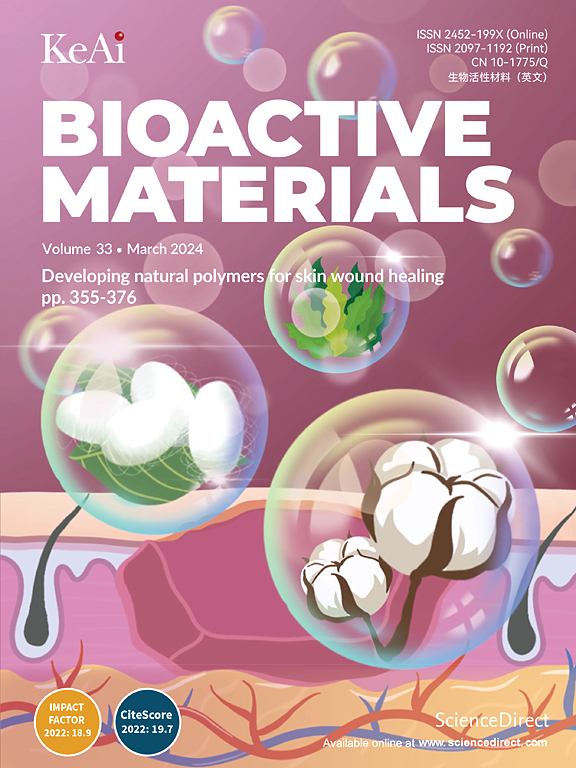Engineering a stem cell-embedded bilayer hydrogel with biomimetic collagen mineralization for tendon-bone interface healing
IF 18
1区 医学
Q1 ENGINEERING, BIOMEDICAL
引用次数: 0
Abstract
The tendon-bone interface effectively transfers mechanical stress for movement, yet its regeneration presents significant clinical challenges due to its hierarchical structure and composition. Biomimetic strategies that replicate the distinctive characteristics have demonstrated potential for enhancing the healing process. However, there remains a challenge in developing a composite that replicates the nanostructure of the tendon-bone interface and embeds living cells. Here, we engineered a nanoscale biomimetic bilayer hydrogel embedded with tendon stem cells for tendon-bone interface healing. Specifically, the biomimetic hydrogel incorporates intra- and extrafibrillar mineralized collagen fibrils as well as non-mineralized collagen fibrils resembling the tendon-bone interface at the nanoscale. Furthermore, biomimetic mineralization with the presence of cells realizes living tendon-bone-like tissue constructs. In the in vivo patella-patellar tendon-interface injury model, the tendon stem cell-laden biomimetic hydrogel promoted tendon-bone interface regeneration, demonstrated by increased fibrocartilage formation, improved motor function, and enhanced biomechanical outcomes. This study highlights the potential of the stem cell-laden biomimetic hydrogel as an effective strategy for tendon-bone interface regeneration, offering a novel approach to engineering complex tissue interfaces.

设计一种具有仿生胶原矿化的干细胞嵌入双层水凝胶用于肌腱-骨界面愈合
肌腱-骨界面有效地传递运动所需的机械应力,但由于其分层结构和组成,其再生面临着重大的临床挑战。复制独特特征的仿生策略已被证明具有增强愈合过程的潜力。然而,在开发一种复制肌腱-骨界面纳米结构并嵌入活细胞的复合材料方面仍然存在挑战。在这里,我们设计了一种纳米级仿生双层水凝胶,嵌入肌腱干细胞,用于肌腱-骨界面愈合。具体来说,仿生水凝胶结合了纤维内和纤维外的矿化胶原原纤维以及类似于纳米级肌腱-骨界面的非矿化胶原原纤维。此外,细胞存在的仿生矿化实现了活肌腱-骨样组织结构。在体内髌骨-髌骨肌腱界面损伤模型中,承载肌腱干细胞的仿生水凝胶促进了肌腱-骨界面再生,表现为纤维软骨形成增加,运动功能改善,生物力学结果增强。本研究强调了干细胞负载仿生水凝胶作为肌腱-骨界面再生的有效策略的潜力,为复杂组织界面的工程设计提供了一种新的方法。
本文章由计算机程序翻译,如有差异,请以英文原文为准。
求助全文
约1分钟内获得全文
求助全文
来源期刊

Bioactive Materials
Biochemistry, Genetics and Molecular Biology-Biotechnology
CiteScore
28.00
自引率
6.30%
发文量
436
审稿时长
20 days
期刊介绍:
Bioactive Materials is a peer-reviewed research publication that focuses on advancements in bioactive materials. The journal accepts research papers, reviews, and rapid communications in the field of next-generation biomaterials that interact with cells, tissues, and organs in various living organisms.
The primary goal of Bioactive Materials is to promote the science and engineering of biomaterials that exhibit adaptiveness to the biological environment. These materials are specifically designed to stimulate or direct appropriate cell and tissue responses or regulate interactions with microorganisms.
The journal covers a wide range of bioactive materials, including those that are engineered or designed in terms of their physical form (e.g. particulate, fiber), topology (e.g. porosity, surface roughness), or dimensions (ranging from macro to nano-scales). Contributions are sought from the following categories of bioactive materials:
Bioactive metals and alloys
Bioactive inorganics: ceramics, glasses, and carbon-based materials
Bioactive polymers and gels
Bioactive materials derived from natural sources
Bioactive composites
These materials find applications in human and veterinary medicine, such as implants, tissue engineering scaffolds, cell/drug/gene carriers, as well as imaging and sensing devices.
 求助内容:
求助内容: 应助结果提醒方式:
应助结果提醒方式:


